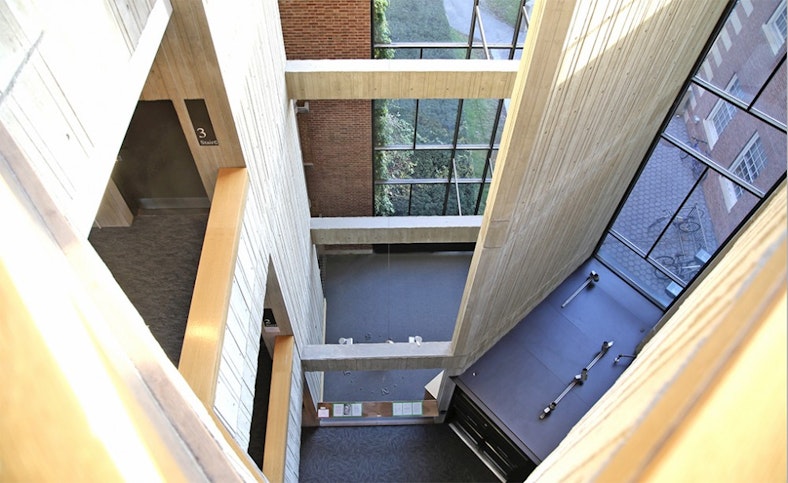
Three weeks ago, during my first week at Dartmouth, I found myself needing a study space. Anything would do, so I blindly followed my friends to a library that was slightly closer than your standard Baker-Berry. On our journey to the Kresge Physical Sciences Library, located on the third floor of Fairchild Hall, I came across a beautiful golden pendulum that immediately captivated me and my friends.
The pendulum was hard to miss: It’s big, it’s picturesque and, most importantly, it’s something you can physically see. Only after a few minutes in the lowermost floor of Fairchild Hall did anyone stop and comment on the peculiar rumbling in the background. We all immediately dismissed it, assuming it was probably just how the acoustics work. Within the following weeks, I returned to Fairchild Hall, making it my home whenever I absolutely needed to get an assignment done.
Later, I found out that the rumbling my friends and I had first noticed, and I had grown accustomed to, was in fact a sound art installation: “Transmission,” by Danish artist and composer Jacob Kirkegaard.
Since age six, Kirkegaard has been fascinated with recording. Years later, at age 19, Kirkegaard made a more deliberate decision to record his surroundings and make sound compositions out of them.
“I moved away from the idea of music making and [started] thinking of it as sound, or sculpturing with sound,” he said.
Kirkegaard’s sound compositions range anywhere from the melting of glaciers in Greenland to the abandoned spaces of the infamous nuclear power plant in Chernobyl, Ukraine. As opposed to traditional paintings and drawings or visual art, Kirkegaard finds sound art appealing because the medium lends itself to subjectivity.
“The visual sense is more objective ... what you see is concrete,” Kirkegaard said. “If you look at something, you know it’s in front of you. It’s not behind you, necessarily. Whereas sound can come from everywhere. You can work with vibrations of sound that can literally vibrate your body. You can feel it but you can’t see it.”
To Kirkegaard, sound can tell us something about the world or ourselves on a different level — subjective, maybe — that can add to our fuller comprehension of things. As an artist, Kirkegaard tries to “refrain from saying you have to feel this or that — or to look for answers — but just to explore a field and sort of create this sonic entrance into something.”
Through sound art, Kirkegaard appeals to a listener in a unique way specific to an individual, revealing something complex about the listener’s surroundings and who that listener is on a personal level.
At Dartmouth, Kirkegaard was commissioned to install his sound art piece, “Transmission.” Choosing the atrium in Fairchild as the location for his composition, he created a space where the sounds shift and alter depending on where you are in this tower-like structure. The 90-minute composition features ambient resonant seismic vibrations of rock structures located in Utah and Arizona. Many of these rock structures are considered sacred sites by Native Americans of the region, including the Hopi, Kaibab Paiute, Navajo, San Juan Southern Paiute, White Mesa Ute and Zuni tribes.
To many a Dartmouth student, including myself, Fairchild has become a home of sorts. Some spend countless nights stargazing in the atrium, others find the perfect nook to lay out all of their study materials and finally write that paper. With his creation of an immersive sound piece in “Transmission,” Kirkegaard has changed that original idea of home in a subtle but impactful way.
When creating “Transmission,” Kirkegaard kept in mind that Fairchild belongs to the students and professors who inhabit it. He didn’t want to “intrude” with his sound recordings, but he did want to “show [us] something else.”
Since the addition of “Transmission,” the low rumblings of Native American rock structures have become integral to my idea of studying in Fairchild — my idea of studying at home.
To several other students at Dartmouth, “Transmission” is an entirely separate manifestation of home. The College we all hold dear to our hearts was originally founded as a means of educating local Native Americans. Despite those claims, Dartmouth focused primarily on graduating white Americans, making it a difficult environment for Native Americans to legitimately thrive. Since then, the College has improved its relationship with the Native American community.
That being said, for someNative American students on campus, this is a difficult and complex history to grapple with when thinking about Dartmouth. “Transmission” is an installation that for some, could be perceived deeply tied to Native American tradition. Having such art at Dartmouth not only acknowledges the College’s past but respects Native American tradition and cements it into the landscape of the campus.
In the words of Kirkegaard, “Transmission” sonically connects the present and the past.
“Listening to the sounds of these arches is the sound of the past but are also the sounds that have been used for thousands of years by people who are still there,” Kirkegaard said. “It’s a sound that you can still hear.”
To have these sounds on campus, connecting our history to the contemporary, is for many what defines a home.



